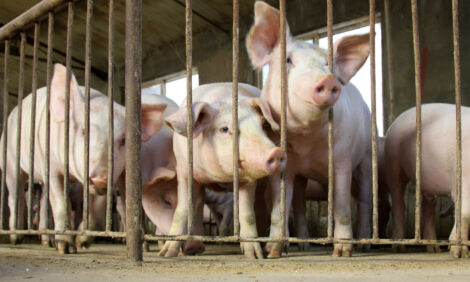



Biosecurity, Gentle Pig Handling Cut Contamination Risk
UK - Improved cleaning and disinfection (C&D) procedures at one pig slaughterhouse have resulted in almost no swabs positive for Salmonella and Enterobacteria, according to a new BPEX study.In a Case Study carried out with F.A. Gill Limited, swabs were taken between the lairage and the carcass chiller. Swabbing was carried out at pre-kill, when the line was completely empty, allowing for a normal clean, disinfect and some air drying. All areas of the abattoir and equipment appeared clean (with used swabs remaining white in most areas). The lairage was stocked with some pigs in pens.
Swabs were taken from key risk areas and ‘control’ areas along the line. Photographs were taken to allow specific identification.
The ‘control’ swabs were taken to judge if C&D was effective in easy to clean areas – such as walk ways and gut pans.
Salmonella Results
The results for the lairage and pre-stun race were all negative: this is a good reflection of the recent investment in the refurbishment programme and of the level of cleanliness that was obvious in the area.
Pigs are natural carriers of Salmonella, and shed very high levels when they are stressed, which can then go on to contaminate the end-product. Pigs being unloaded at Gills were not rushed or cajoled along, and were calmly guided using a pig board. It was clear that the handling system and staff in the lairage are considerate towards the welfare of the pig.
All the swabs taken on the slaughter line were negative for Salmonella. Dehairers and polishers are a key area for circulating contamination between carcasses (being difficult to clean effectively), but no positive results were returned for this area either.
Enterobacteria Results
All the swabs taken from line equipment were negative for Enterobacteria apart from one steriliser. Sterilisers are hard to clean, particularly if knives are not cleaned before sterilisation. This also highlights that maintaining a suitable temperature throughout the day is vital in reducing contamination.
The saw blade is removed nightly and effectively sterilised, giving a negative reading as a result. This piece of machinery could potentially contaminate every carcase on the line if the blade became contaminated.
The floor and wall area swabbed in the chiller was negative. Given Enterobacteria primarily live in the digestive tract, any positive swabs at this stage could indicate that carcases are not being effectively trimmed after becoming contaminated.
Conclusions
There were exceptional results for the lairage, line and equipment, which clearly reflect the recent investments and a highly effective C&D programme. Gills are working hard to maintain this high level of cleanliness.







